Accounting and Finance Report: Saturn and ARB Limited Analysis
VerifiedAdded on 2021/06/17
|16
|2336
|30
Report
AI Summary
This report presents a comprehensive analysis of accounting and finance principles through two case studies. Part A focuses on Saturn Pet Care, evaluating capital budgeting decisions for the Bathurst and Wodonga projects using techniques like net present value, profitability index, and payback period. It also addresses product cannibalization, sales budget errors, and the inclusion of original factory costs. Part B analyzes ARB Limited's capital structure, calculating WACC, determining the appropriate return using CAPM, and comparing the company's structure with industry peers. The report examines financial ratios, analyzes changes in capital structure over three years, and assesses shareholder wealth maximization, providing recommendations for improvement. The report uses various financial tools and techniques to assess the financial health of the companies.
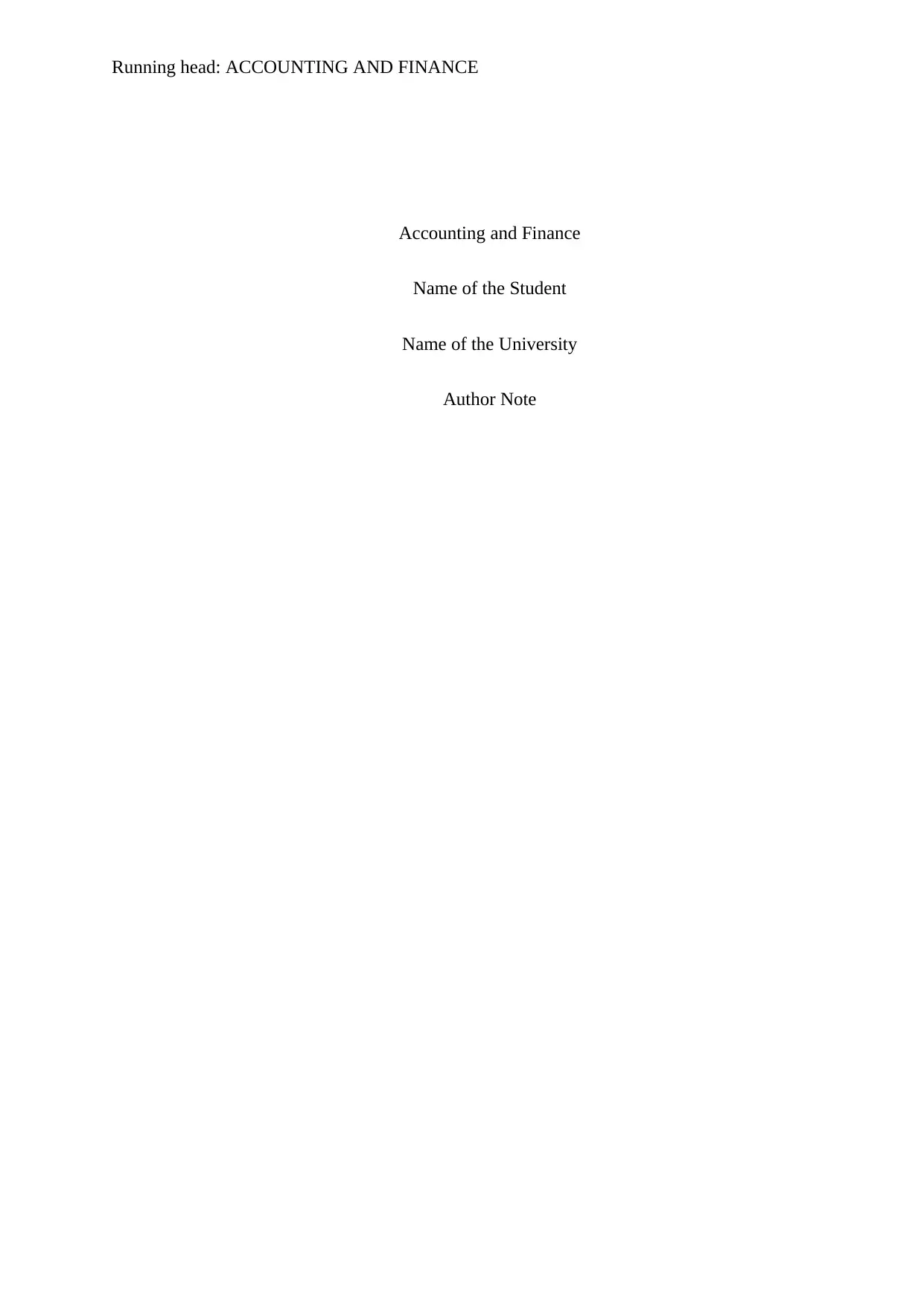
Running head: ACCOUNTING AND FINANCE
Accounting and Finance
Name of the Student
Name of the University
Author Note
Accounting and Finance
Name of the Student
Name of the University
Author Note
Paraphrase This Document
Need a fresh take? Get an instant paraphrase of this document with our AI Paraphraser
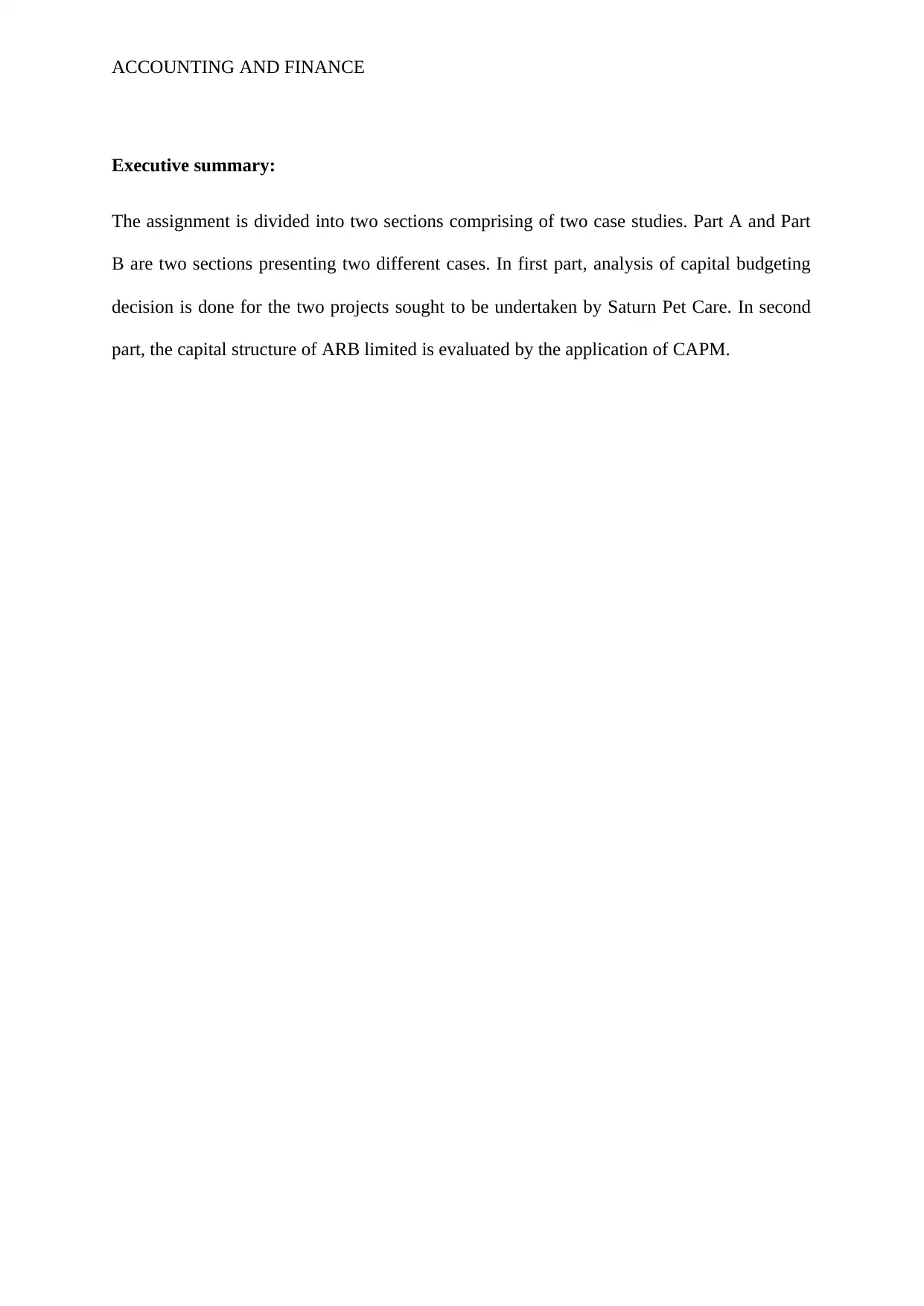
ACCOUNTING AND FINANCE
Executive summary:
The assignment is divided into two sections comprising of two case studies. Part A and Part
B are two sections presenting two different cases. In first part, analysis of capital budgeting
decision is done for the two projects sought to be undertaken by Saturn Pet Care. In second
part, the capital structure of ARB limited is evaluated by the application of CAPM.
Executive summary:
The assignment is divided into two sections comprising of two case studies. Part A and Part
B are two sections presenting two different cases. In first part, analysis of capital budgeting
decision is done for the two projects sought to be undertaken by Saturn Pet Care. In second
part, the capital structure of ARB limited is evaluated by the application of CAPM.
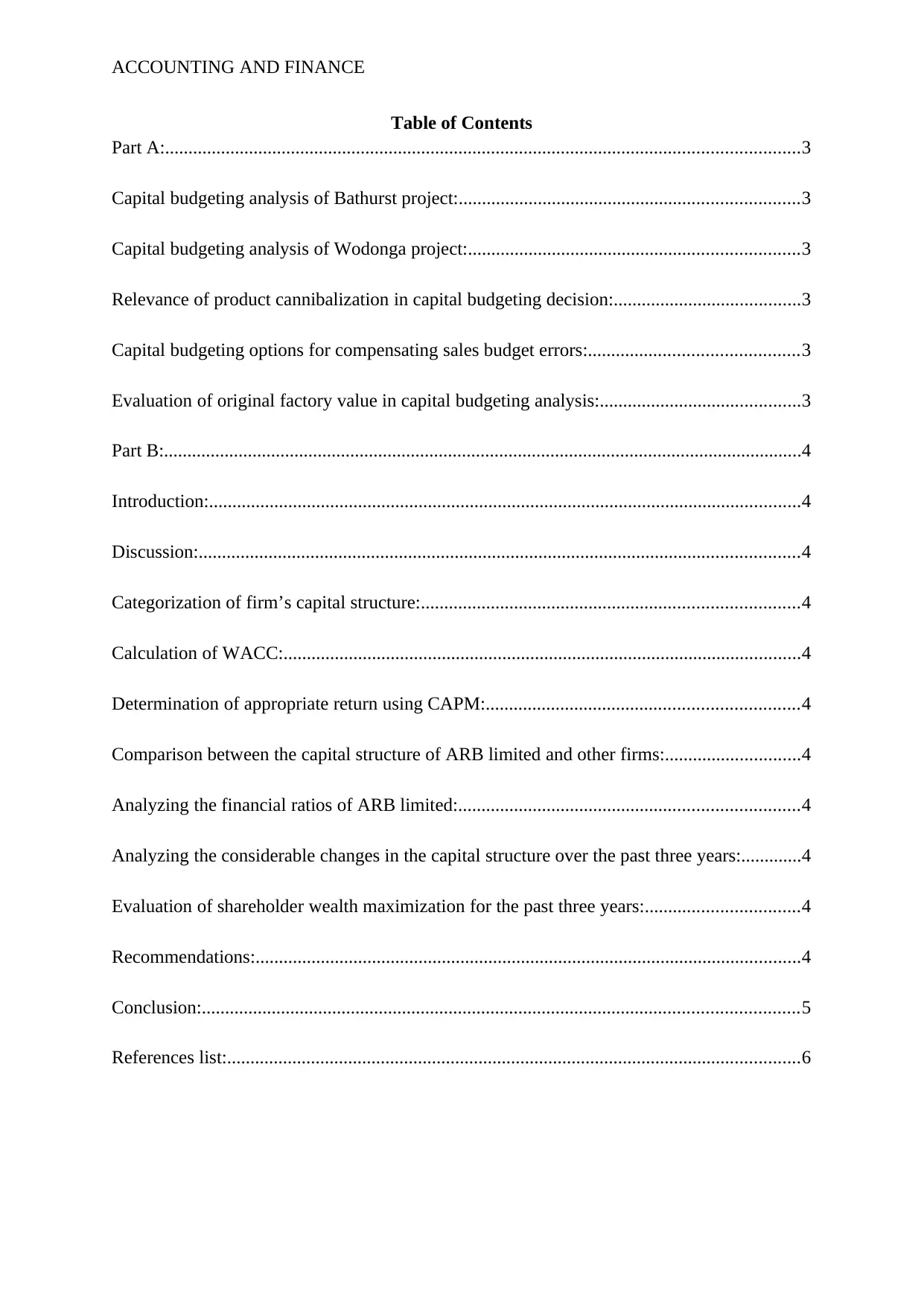
ACCOUNTING AND FINANCE
Table of Contents
Part A:........................................................................................................................................3
Capital budgeting analysis of Bathurst project:.........................................................................3
Capital budgeting analysis of Wodonga project:.......................................................................3
Relevance of product cannibalization in capital budgeting decision:........................................3
Capital budgeting options for compensating sales budget errors:.............................................3
Evaluation of original factory value in capital budgeting analysis:...........................................3
Part B:.........................................................................................................................................4
Introduction:...............................................................................................................................4
Discussion:.................................................................................................................................4
Categorization of firm’s capital structure:.................................................................................4
Calculation of WACC:...............................................................................................................4
Determination of appropriate return using CAPM:...................................................................4
Comparison between the capital structure of ARB limited and other firms:.............................4
Analyzing the financial ratios of ARB limited:.........................................................................4
Analyzing the considerable changes in the capital structure over the past three years:.............4
Evaluation of shareholder wealth maximization for the past three years:.................................4
Recommendations:.....................................................................................................................4
Conclusion:................................................................................................................................5
References list:...........................................................................................................................6
Table of Contents
Part A:........................................................................................................................................3
Capital budgeting analysis of Bathurst project:.........................................................................3
Capital budgeting analysis of Wodonga project:.......................................................................3
Relevance of product cannibalization in capital budgeting decision:........................................3
Capital budgeting options for compensating sales budget errors:.............................................3
Evaluation of original factory value in capital budgeting analysis:...........................................3
Part B:.........................................................................................................................................4
Introduction:...............................................................................................................................4
Discussion:.................................................................................................................................4
Categorization of firm’s capital structure:.................................................................................4
Calculation of WACC:...............................................................................................................4
Determination of appropriate return using CAPM:...................................................................4
Comparison between the capital structure of ARB limited and other firms:.............................4
Analyzing the financial ratios of ARB limited:.........................................................................4
Analyzing the considerable changes in the capital structure over the past three years:.............4
Evaluation of shareholder wealth maximization for the past three years:.................................4
Recommendations:.....................................................................................................................4
Conclusion:................................................................................................................................5
References list:...........................................................................................................................6
⊘ This is a preview!⊘
Do you want full access?
Subscribe today to unlock all pages.

Trusted by 1+ million students worldwide
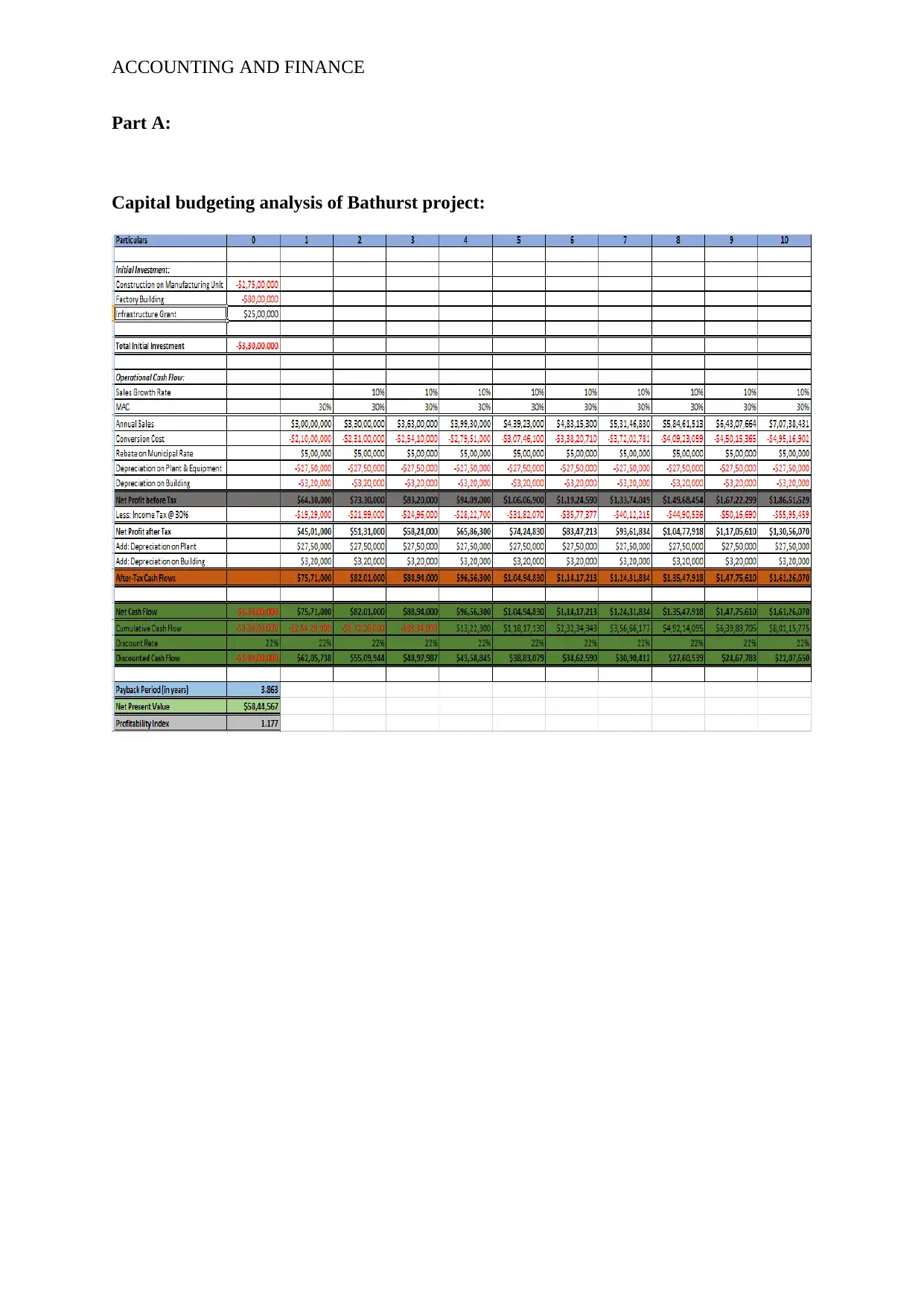
ACCOUNTING AND FINANCE
Part A:
Capital budgeting analysis of Bathurst project:
Part A:
Capital budgeting analysis of Bathurst project:
Paraphrase This Document
Need a fresh take? Get an instant paraphrase of this document with our AI Paraphraser
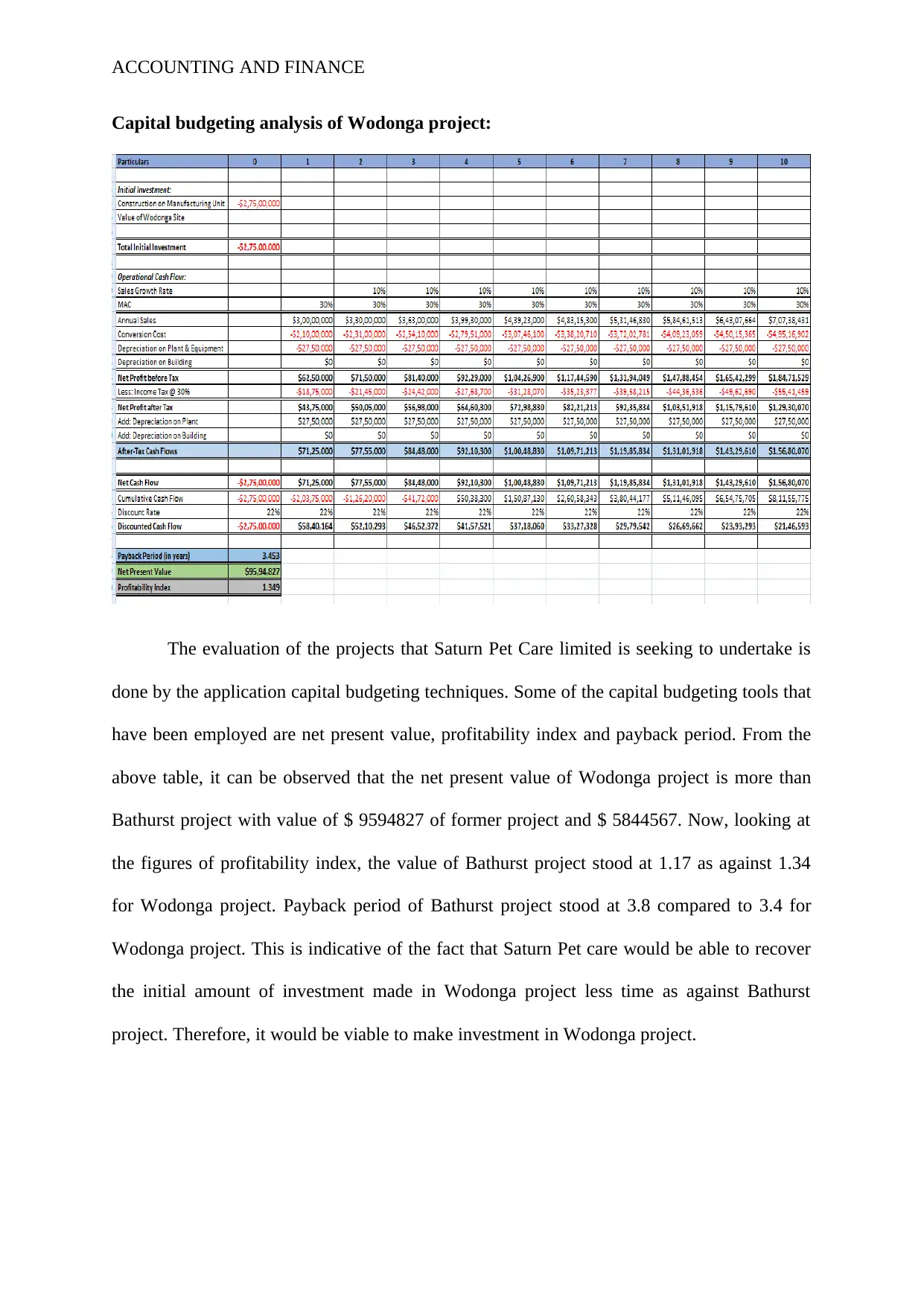
ACCOUNTING AND FINANCE
Capital budgeting analysis of Wodonga project:
The evaluation of the projects that Saturn Pet Care limited is seeking to undertake is
done by the application capital budgeting techniques. Some of the capital budgeting tools that
have been employed are net present value, profitability index and payback period. From the
above table, it can be observed that the net present value of Wodonga project is more than
Bathurst project with value of $ 9594827 of former project and $ 5844567. Now, looking at
the figures of profitability index, the value of Bathurst project stood at 1.17 as against 1.34
for Wodonga project. Payback period of Bathurst project stood at 3.8 compared to 3.4 for
Wodonga project. This is indicative of the fact that Saturn Pet care would be able to recover
the initial amount of investment made in Wodonga project less time as against Bathurst
project. Therefore, it would be viable to make investment in Wodonga project.
Capital budgeting analysis of Wodonga project:
The evaluation of the projects that Saturn Pet Care limited is seeking to undertake is
done by the application capital budgeting techniques. Some of the capital budgeting tools that
have been employed are net present value, profitability index and payback period. From the
above table, it can be observed that the net present value of Wodonga project is more than
Bathurst project with value of $ 9594827 of former project and $ 5844567. Now, looking at
the figures of profitability index, the value of Bathurst project stood at 1.17 as against 1.34
for Wodonga project. Payback period of Bathurst project stood at 3.8 compared to 3.4 for
Wodonga project. This is indicative of the fact that Saturn Pet care would be able to recover
the initial amount of investment made in Wodonga project less time as against Bathurst
project. Therefore, it would be viable to make investment in Wodonga project.
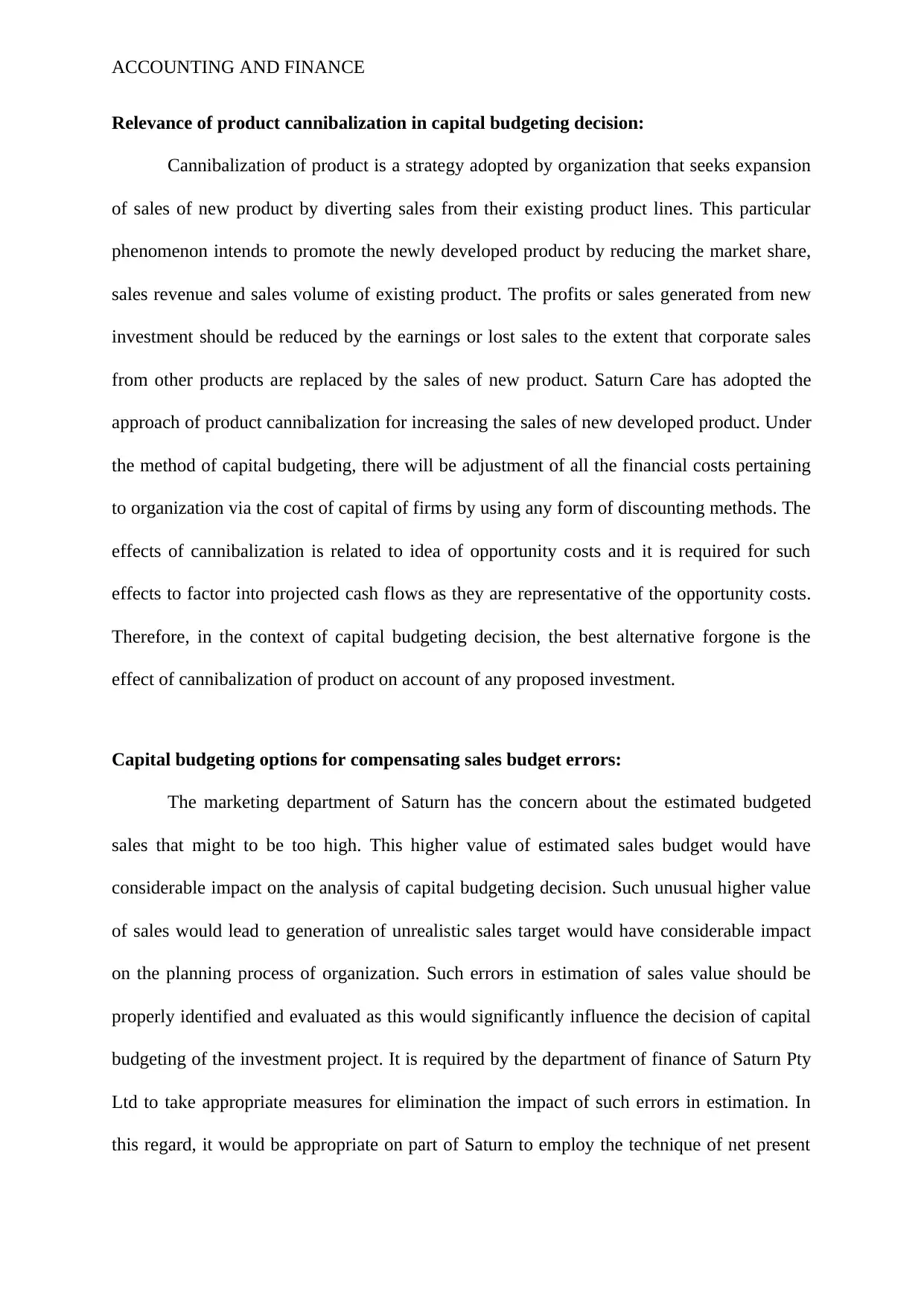
ACCOUNTING AND FINANCE
Relevance of product cannibalization in capital budgeting decision:
Cannibalization of product is a strategy adopted by organization that seeks expansion
of sales of new product by diverting sales from their existing product lines. This particular
phenomenon intends to promote the newly developed product by reducing the market share,
sales revenue and sales volume of existing product. The profits or sales generated from new
investment should be reduced by the earnings or lost sales to the extent that corporate sales
from other products are replaced by the sales of new product. Saturn Care has adopted the
approach of product cannibalization for increasing the sales of new developed product. Under
the method of capital budgeting, there will be adjustment of all the financial costs pertaining
to organization via the cost of capital of firms by using any form of discounting methods. The
effects of cannibalization is related to idea of opportunity costs and it is required for such
effects to factor into projected cash flows as they are representative of the opportunity costs.
Therefore, in the context of capital budgeting decision, the best alternative forgone is the
effect of cannibalization of product on account of any proposed investment.
Capital budgeting options for compensating sales budget errors:
The marketing department of Saturn has the concern about the estimated budgeted
sales that might to be too high. This higher value of estimated sales budget would have
considerable impact on the analysis of capital budgeting decision. Such unusual higher value
of sales would lead to generation of unrealistic sales target would have considerable impact
on the planning process of organization. Such errors in estimation of sales value should be
properly identified and evaluated as this would significantly influence the decision of capital
budgeting of the investment project. It is required by the department of finance of Saturn Pty
Ltd to take appropriate measures for elimination the impact of such errors in estimation. In
this regard, it would be appropriate on part of Saturn to employ the technique of net present
Relevance of product cannibalization in capital budgeting decision:
Cannibalization of product is a strategy adopted by organization that seeks expansion
of sales of new product by diverting sales from their existing product lines. This particular
phenomenon intends to promote the newly developed product by reducing the market share,
sales revenue and sales volume of existing product. The profits or sales generated from new
investment should be reduced by the earnings or lost sales to the extent that corporate sales
from other products are replaced by the sales of new product. Saturn Care has adopted the
approach of product cannibalization for increasing the sales of new developed product. Under
the method of capital budgeting, there will be adjustment of all the financial costs pertaining
to organization via the cost of capital of firms by using any form of discounting methods. The
effects of cannibalization is related to idea of opportunity costs and it is required for such
effects to factor into projected cash flows as they are representative of the opportunity costs.
Therefore, in the context of capital budgeting decision, the best alternative forgone is the
effect of cannibalization of product on account of any proposed investment.
Capital budgeting options for compensating sales budget errors:
The marketing department of Saturn has the concern about the estimated budgeted
sales that might to be too high. This higher value of estimated sales budget would have
considerable impact on the analysis of capital budgeting decision. Such unusual higher value
of sales would lead to generation of unrealistic sales target would have considerable impact
on the planning process of organization. Such errors in estimation of sales value should be
properly identified and evaluated as this would significantly influence the decision of capital
budgeting of the investment project. It is required by the department of finance of Saturn Pty
Ltd to take appropriate measures for elimination the impact of such errors in estimation. In
this regard, it would be appropriate on part of Saturn to employ the technique of net present
⊘ This is a preview!⊘
Do you want full access?
Subscribe today to unlock all pages.

Trusted by 1+ million students worldwide
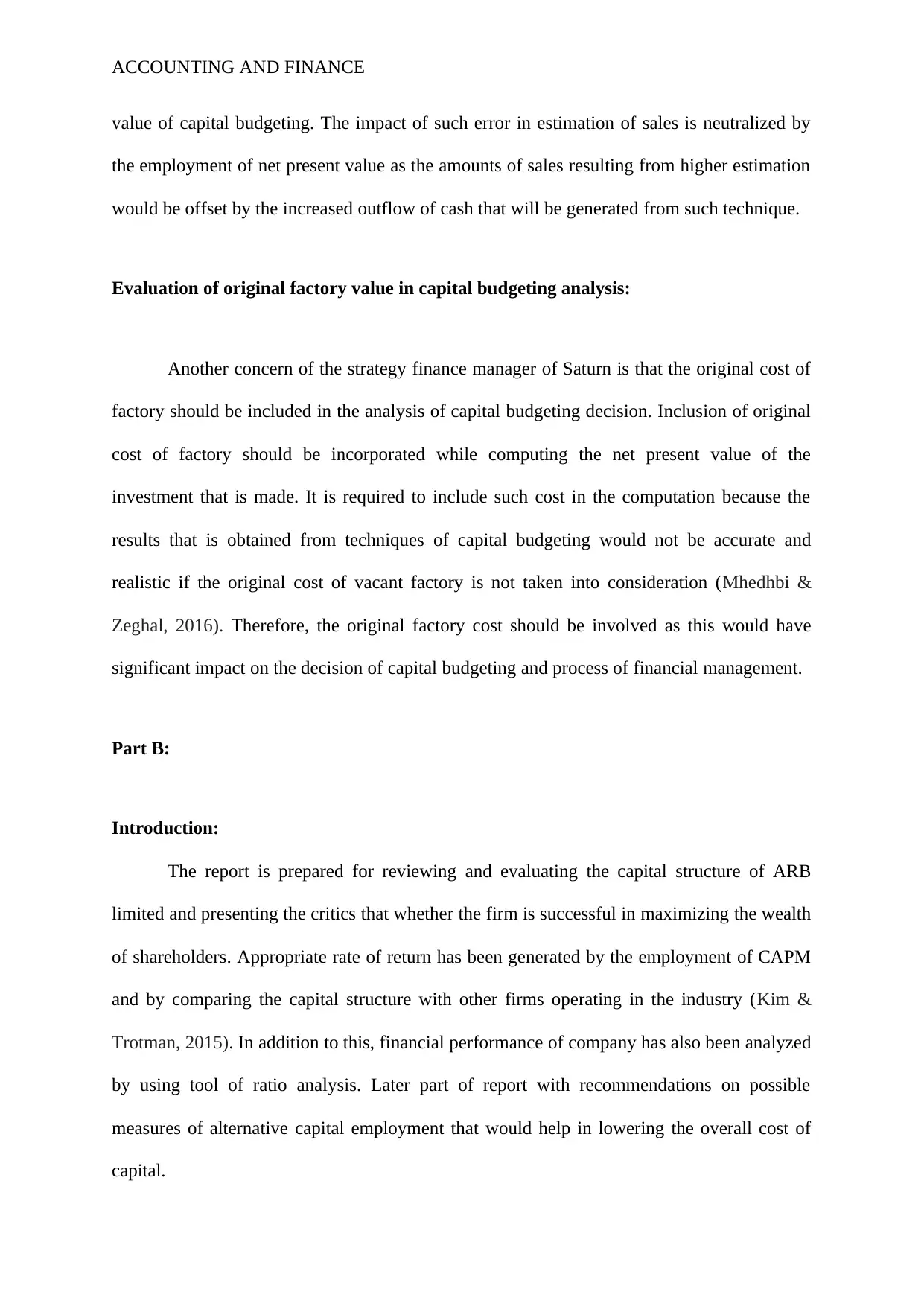
ACCOUNTING AND FINANCE
value of capital budgeting. The impact of such error in estimation of sales is neutralized by
the employment of net present value as the amounts of sales resulting from higher estimation
would be offset by the increased outflow of cash that will be generated from such technique.
Evaluation of original factory value in capital budgeting analysis:
Another concern of the strategy finance manager of Saturn is that the original cost of
factory should be included in the analysis of capital budgeting decision. Inclusion of original
cost of factory should be incorporated while computing the net present value of the
investment that is made. It is required to include such cost in the computation because the
results that is obtained from techniques of capital budgeting would not be accurate and
realistic if the original cost of vacant factory is not taken into consideration (Mhedhbi &
Zeghal, 2016). Therefore, the original factory cost should be involved as this would have
significant impact on the decision of capital budgeting and process of financial management.
Part B:
Introduction:
The report is prepared for reviewing and evaluating the capital structure of ARB
limited and presenting the critics that whether the firm is successful in maximizing the wealth
of shareholders. Appropriate rate of return has been generated by the employment of CAPM
and by comparing the capital structure with other firms operating in the industry (Kim &
Trotman, 2015). In addition to this, financial performance of company has also been analyzed
by using tool of ratio analysis. Later part of report with recommendations on possible
measures of alternative capital employment that would help in lowering the overall cost of
capital.
value of capital budgeting. The impact of such error in estimation of sales is neutralized by
the employment of net present value as the amounts of sales resulting from higher estimation
would be offset by the increased outflow of cash that will be generated from such technique.
Evaluation of original factory value in capital budgeting analysis:
Another concern of the strategy finance manager of Saturn is that the original cost of
factory should be included in the analysis of capital budgeting decision. Inclusion of original
cost of factory should be incorporated while computing the net present value of the
investment that is made. It is required to include such cost in the computation because the
results that is obtained from techniques of capital budgeting would not be accurate and
realistic if the original cost of vacant factory is not taken into consideration (Mhedhbi &
Zeghal, 2016). Therefore, the original factory cost should be involved as this would have
significant impact on the decision of capital budgeting and process of financial management.
Part B:
Introduction:
The report is prepared for reviewing and evaluating the capital structure of ARB
limited and presenting the critics that whether the firm is successful in maximizing the wealth
of shareholders. Appropriate rate of return has been generated by the employment of CAPM
and by comparing the capital structure with other firms operating in the industry (Kim &
Trotman, 2015). In addition to this, financial performance of company has also been analyzed
by using tool of ratio analysis. Later part of report with recommendations on possible
measures of alternative capital employment that would help in lowering the overall cost of
capital.
Paraphrase This Document
Need a fresh take? Get an instant paraphrase of this document with our AI Paraphraser
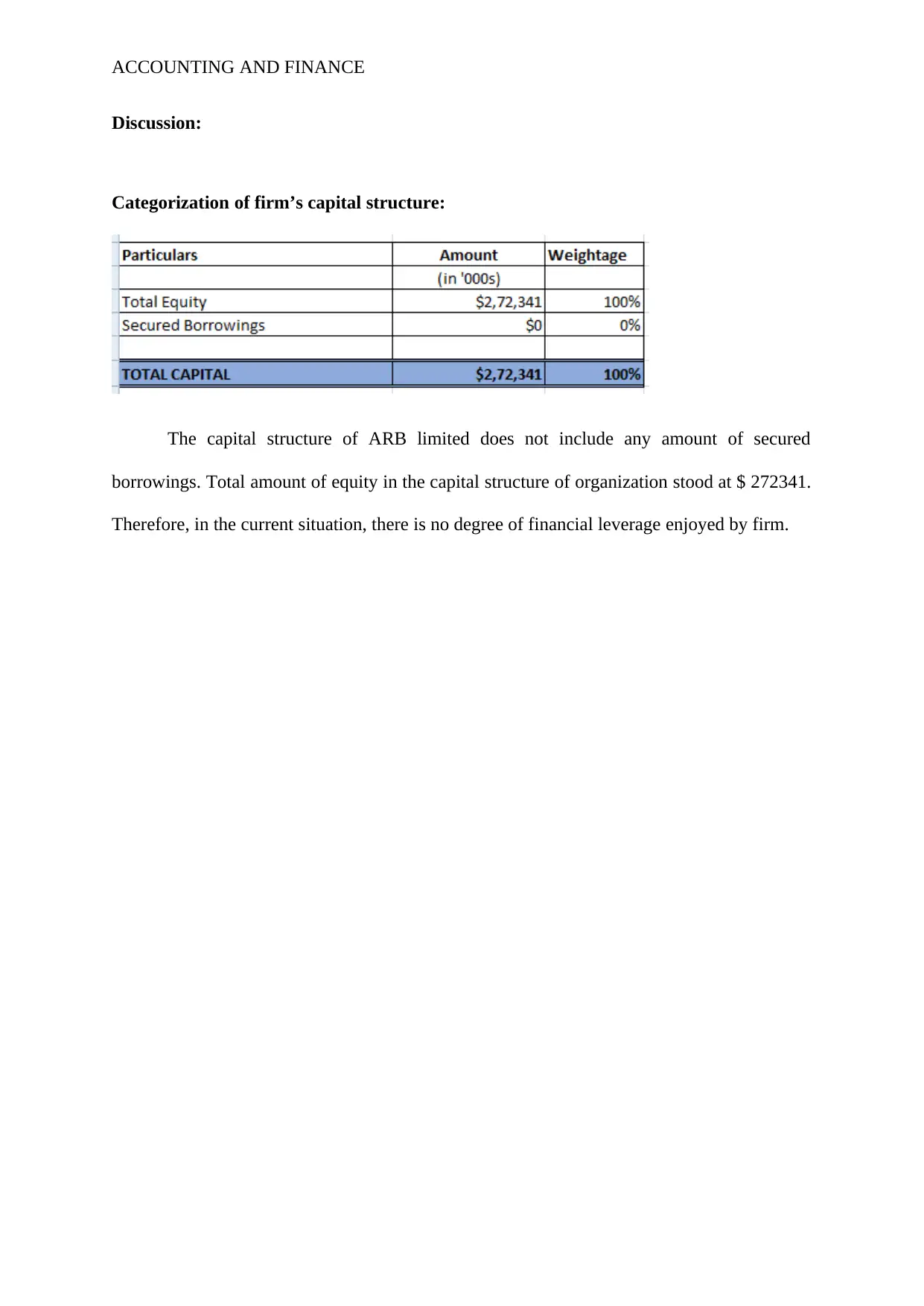
ACCOUNTING AND FINANCE
Discussion:
Categorization of firm’s capital structure:
The capital structure of ARB limited does not include any amount of secured
borrowings. Total amount of equity in the capital structure of organization stood at $ 272341.
Therefore, in the current situation, there is no degree of financial leverage enjoyed by firm.
Discussion:
Categorization of firm’s capital structure:
The capital structure of ARB limited does not include any amount of secured
borrowings. Total amount of equity in the capital structure of organization stood at $ 272341.
Therefore, in the current situation, there is no degree of financial leverage enjoyed by firm.
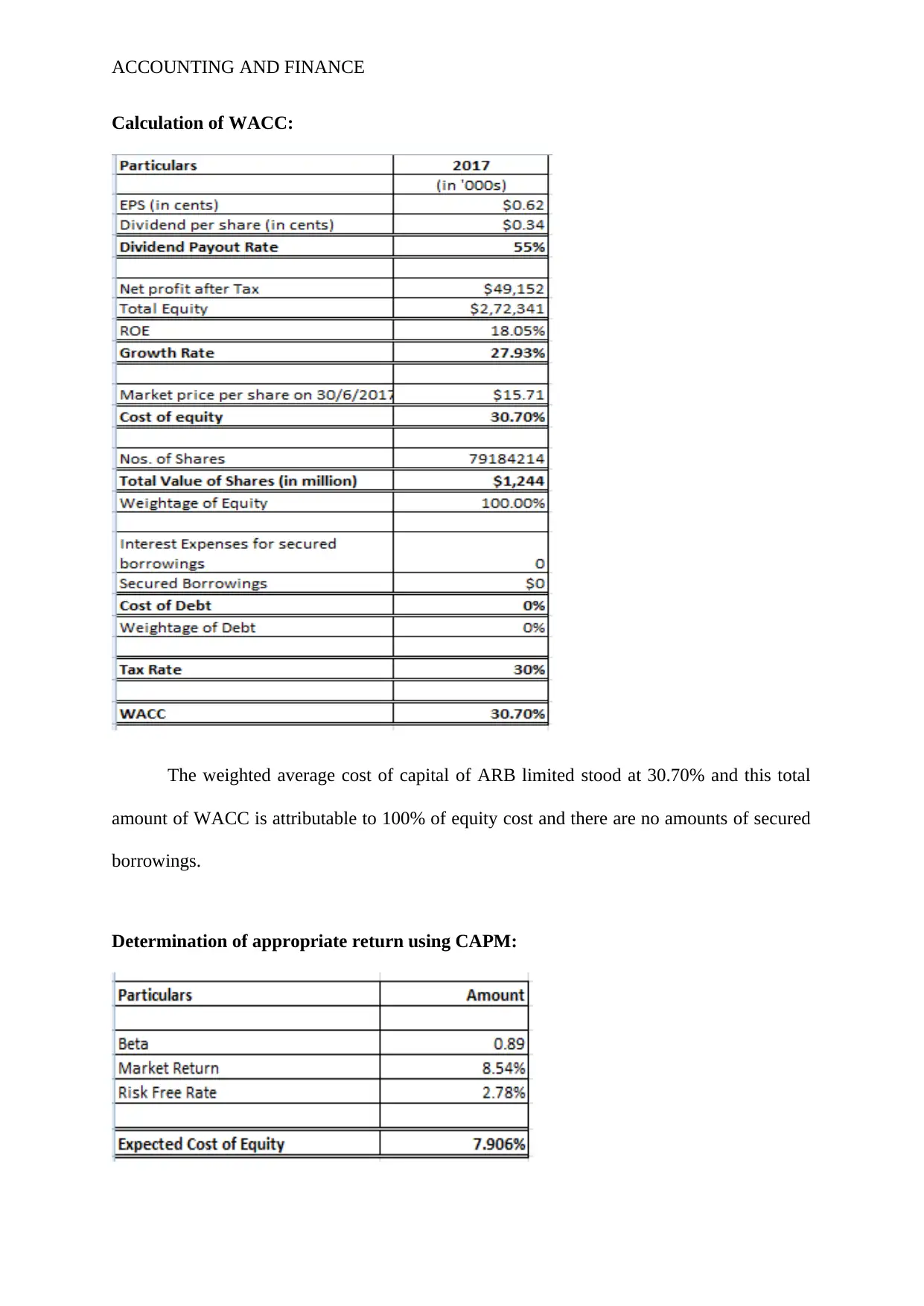
ACCOUNTING AND FINANCE
Calculation of WACC:
The weighted average cost of capital of ARB limited stood at 30.70% and this total
amount of WACC is attributable to 100% of equity cost and there are no amounts of secured
borrowings.
Determination of appropriate return using CAPM:
Calculation of WACC:
The weighted average cost of capital of ARB limited stood at 30.70% and this total
amount of WACC is attributable to 100% of equity cost and there are no amounts of secured
borrowings.
Determination of appropriate return using CAPM:
⊘ This is a preview!⊘
Do you want full access?
Subscribe today to unlock all pages.

Trusted by 1+ million students worldwide
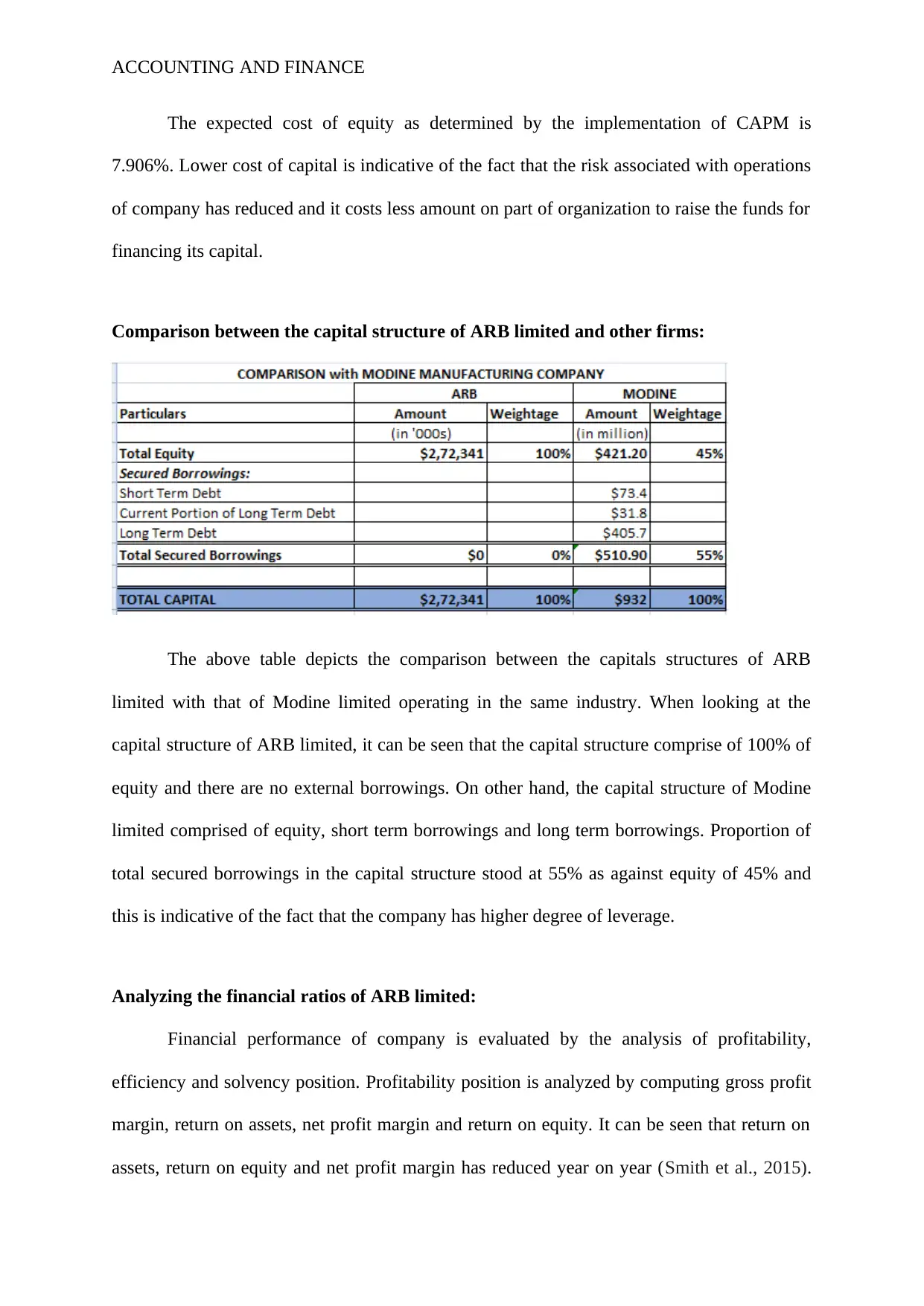
ACCOUNTING AND FINANCE
The expected cost of equity as determined by the implementation of CAPM is
7.906%. Lower cost of capital is indicative of the fact that the risk associated with operations
of company has reduced and it costs less amount on part of organization to raise the funds for
financing its capital.
Comparison between the capital structure of ARB limited and other firms:
The above table depicts the comparison between the capitals structures of ARB
limited with that of Modine limited operating in the same industry. When looking at the
capital structure of ARB limited, it can be seen that the capital structure comprise of 100% of
equity and there are no external borrowings. On other hand, the capital structure of Modine
limited comprised of equity, short term borrowings and long term borrowings. Proportion of
total secured borrowings in the capital structure stood at 55% as against equity of 45% and
this is indicative of the fact that the company has higher degree of leverage.
Analyzing the financial ratios of ARB limited:
Financial performance of company is evaluated by the analysis of profitability,
efficiency and solvency position. Profitability position is analyzed by computing gross profit
margin, return on assets, net profit margin and return on equity. It can be seen that return on
assets, return on equity and net profit margin has reduced year on year (Smith et al., 2015).
The expected cost of equity as determined by the implementation of CAPM is
7.906%. Lower cost of capital is indicative of the fact that the risk associated with operations
of company has reduced and it costs less amount on part of organization to raise the funds for
financing its capital.
Comparison between the capital structure of ARB limited and other firms:
The above table depicts the comparison between the capitals structures of ARB
limited with that of Modine limited operating in the same industry. When looking at the
capital structure of ARB limited, it can be seen that the capital structure comprise of 100% of
equity and there are no external borrowings. On other hand, the capital structure of Modine
limited comprised of equity, short term borrowings and long term borrowings. Proportion of
total secured borrowings in the capital structure stood at 55% as against equity of 45% and
this is indicative of the fact that the company has higher degree of leverage.
Analyzing the financial ratios of ARB limited:
Financial performance of company is evaluated by the analysis of profitability,
efficiency and solvency position. Profitability position is analyzed by computing gross profit
margin, return on assets, net profit margin and return on equity. It can be seen that return on
assets, return on equity and net profit margin has reduced year on year (Smith et al., 2015).
Paraphrase This Document
Need a fresh take? Get an instant paraphrase of this document with our AI Paraphraser
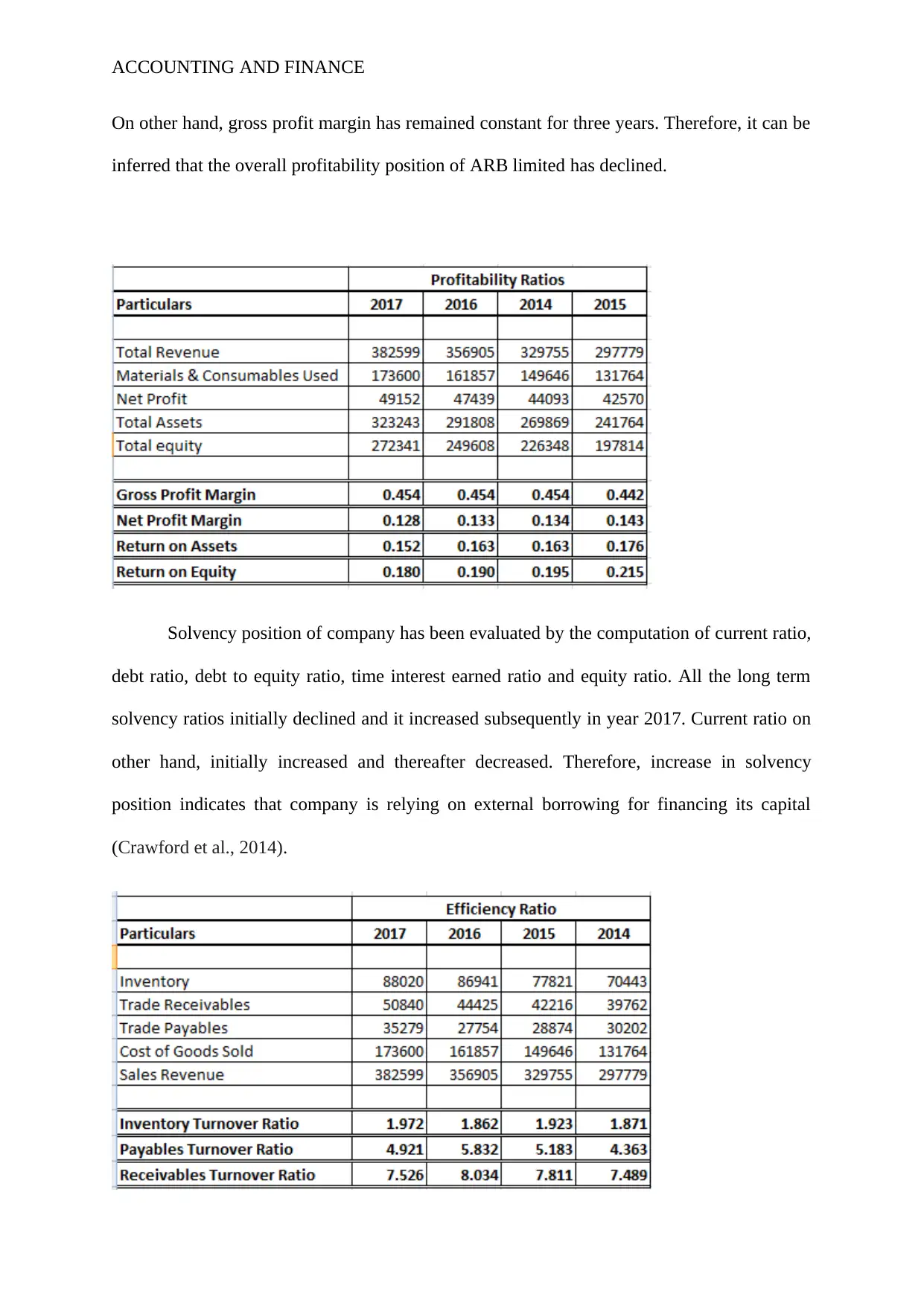
ACCOUNTING AND FINANCE
On other hand, gross profit margin has remained constant for three years. Therefore, it can be
inferred that the overall profitability position of ARB limited has declined.
Solvency position of company has been evaluated by the computation of current ratio,
debt ratio, debt to equity ratio, time interest earned ratio and equity ratio. All the long term
solvency ratios initially declined and it increased subsequently in year 2017. Current ratio on
other hand, initially increased and thereafter decreased. Therefore, increase in solvency
position indicates that company is relying on external borrowing for financing its capital
(Crawford et al., 2014).
On other hand, gross profit margin has remained constant for three years. Therefore, it can be
inferred that the overall profitability position of ARB limited has declined.
Solvency position of company has been evaluated by the computation of current ratio,
debt ratio, debt to equity ratio, time interest earned ratio and equity ratio. All the long term
solvency ratios initially declined and it increased subsequently in year 2017. Current ratio on
other hand, initially increased and thereafter decreased. Therefore, increase in solvency
position indicates that company is relying on external borrowing for financing its capital
(Crawford et al., 2014).
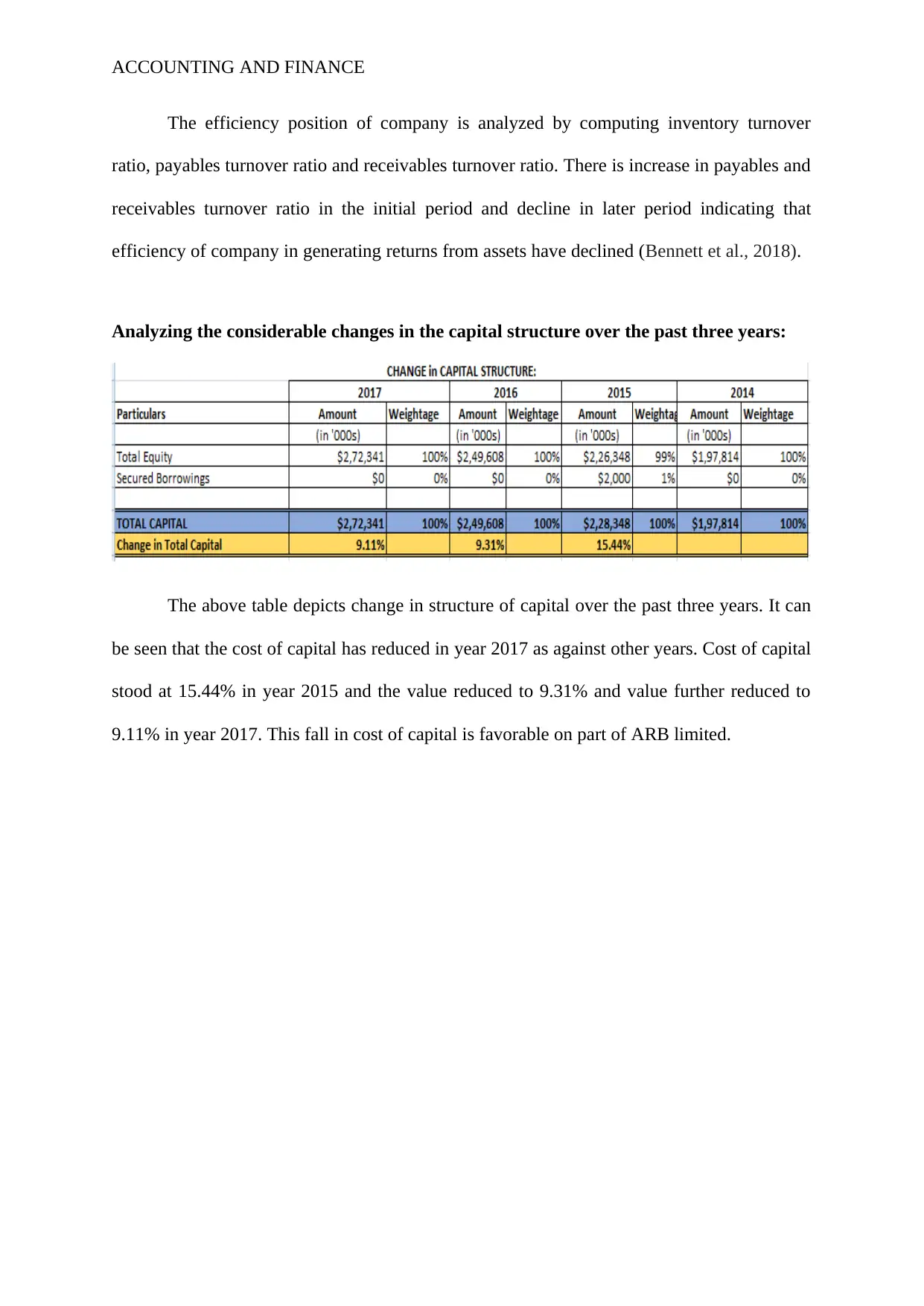
ACCOUNTING AND FINANCE
The efficiency position of company is analyzed by computing inventory turnover
ratio, payables turnover ratio and receivables turnover ratio. There is increase in payables and
receivables turnover ratio in the initial period and decline in later period indicating that
efficiency of company in generating returns from assets have declined (Bennett et al., 2018).
Analyzing the considerable changes in the capital structure over the past three years:
The above table depicts change in structure of capital over the past three years. It can
be seen that the cost of capital has reduced in year 2017 as against other years. Cost of capital
stood at 15.44% in year 2015 and the value reduced to 9.31% and value further reduced to
9.11% in year 2017. This fall in cost of capital is favorable on part of ARB limited.
The efficiency position of company is analyzed by computing inventory turnover
ratio, payables turnover ratio and receivables turnover ratio. There is increase in payables and
receivables turnover ratio in the initial period and decline in later period indicating that
efficiency of company in generating returns from assets have declined (Bennett et al., 2018).
Analyzing the considerable changes in the capital structure over the past three years:
The above table depicts change in structure of capital over the past three years. It can
be seen that the cost of capital has reduced in year 2017 as against other years. Cost of capital
stood at 15.44% in year 2015 and the value reduced to 9.31% and value further reduced to
9.11% in year 2017. This fall in cost of capital is favorable on part of ARB limited.
⊘ This is a preview!⊘
Do you want full access?
Subscribe today to unlock all pages.

Trusted by 1+ million students worldwide
1 out of 16
Related Documents
Your All-in-One AI-Powered Toolkit for Academic Success.
+13062052269
info@desklib.com
Available 24*7 on WhatsApp / Email
![[object Object]](/_next/static/media/star-bottom.7253800d.svg)
Unlock your academic potential
Copyright © 2020–2025 A2Z Services. All Rights Reserved. Developed and managed by ZUCOL.





